Abstract
SEVERAL positive and negative reports have been reviewed recently1,2 on the possibility of transferring acquired behaviour from animal to animal by injecting brain extract from a trained donor into an untrained recipient. We were interested in the possibility of transferring morphine tolerance from rats to mice, as reported by Ungar and Galvan3. We failed to replicate this finding, as had other investigators4,5. Nevertheless, we felt it worthwhile to search for the appropriate conditions and chose Ungar's simpler system of “fear transfer” as a model6,7. Here rats are overtrained (by means of foot shock) to avoid entering a black box; recipient mice are then tested in the same box. To enable us to follow accurately the published procedures one of us (A. G.) spent a few days in Ungar's laboratory. In the next 3 months we carried out eighteen unsuccessful experiments with 125 donor rats and 383 recipient and saline control mice. We then did a blind test in our mice using control and trained donor extracts provided by Dr Ungar. Next, we sent 100 of our mice to Houston, for testing as recipients concurrently with the local strain. Finally, we selected, from all our experiments, those mice (of both sexes) which seemed to avoid the black box more often after receiving the extracts. These animals were bred and the offspring were tested as recipients. We hoped to select for recipient capability that might be under genetic influence. The results of all these experiments were negative or equivocal.
This is a preview of subscription content, access via your institution
Access options
Subscribe to this journal
Receive 51 print issues and online access
$199.00 per year
only $3.90 per issue
Buy this article
- Purchase on Springer Link
- Instant access to full article PDF
Prices may be subject to local taxes which are calculated during checkout
Similar content being viewed by others
References
Ungar, G., in Handbook of Neurochemistry, 3 (edit. by Lajtha, A.) (Plenum Press, New York, 1970).
Ungar, G., in Methods in Pharmacology (edit. by Schwartz, A.) (Appleton-Century-Croft, New York, 1970).
Ungar, G., and Galvan, L., Proc. Soc. Exp. Biol. Med., 130, 287 (1969).
Tirri, R., Experientia, 23, 278 (1967).
Smits, S. E., and Takemori, A. E., Proc. Soc. Exp. Biol. Med., 127, 1167 (1968).
Ungar, G., Galvan, L., and Clark, R. H., Nature, 217, 1259 (1968).
Ungar, G., Fed. Proc., 28, 647 (1969).
Eddy, N. B., and Leimbach, D., J. Pharmacol. Exp. Ther., 107, 385 (1953).
Goldstein, A., and Sheehan, P., J. Pharmacol. Exp. Ther., 169, 175 (1969).
Ungar, G., and Cohen, M., Intern. J. Neuropharmacol., 5, 183 (1966).
Ungar, G., Perspect. Biol. Med., 11, 217 (1968).
Ungar, G., Chapter 5 in Molecular Mechanisms in Memory and Learning (Plenum Press, New York, 1970).
Gay, R., and Raphelson, A., Psychon. Sci., 8, 369 (1967).
Wolthuis, O. L., Arch. Intern. Pharmacodyn., 182, 439 (1969).
Goeub, A. M., Epstein, L., and McConnell, J. V., J. Biol. Psychol., 11, 44 (1969).
Author information
Authors and Affiliations
Rights and permissions
About this article
Cite this article
GOLDSTEIN, A., SHEEHAN, P. & GOLDSTEIN, J. Unsuccessful Attempts to Transfer Morphine Tolerance and Passive Avoidance by Brain Extracts. Nature 233, 126–129 (1971). https://doi.org/10.1038/233126a0
Received:
Revised:
Issue Date:
DOI: https://doi.org/10.1038/233126a0
This article is cited by
-
Role of RNA and protein synthesis in memory formation
Neurochemical Research (1979)
-
Reputed rat scotophobin prepared by a solid-phase procedure shown invalid by comparison with a product derived from a classical synthesis on the basis of physical and biological properties
Experientia (1975)
-
Comments on the “Isolation, Identification and Synthesis of a Specific-behaviour-inducing Brain Peptide”
Nature (1973)
-
Induction (transfer) of an operant behaviour by injection of brain extract
Psychopharmacologia (1973)
-
The problem of molecular coding of neural information
Die Naturwissenschaften (1973)
Comments
By submitting a comment you agree to abide by our Terms and Community Guidelines. If you find something abusive or that does not comply with our terms or guidelines please flag it as inappropriate.



